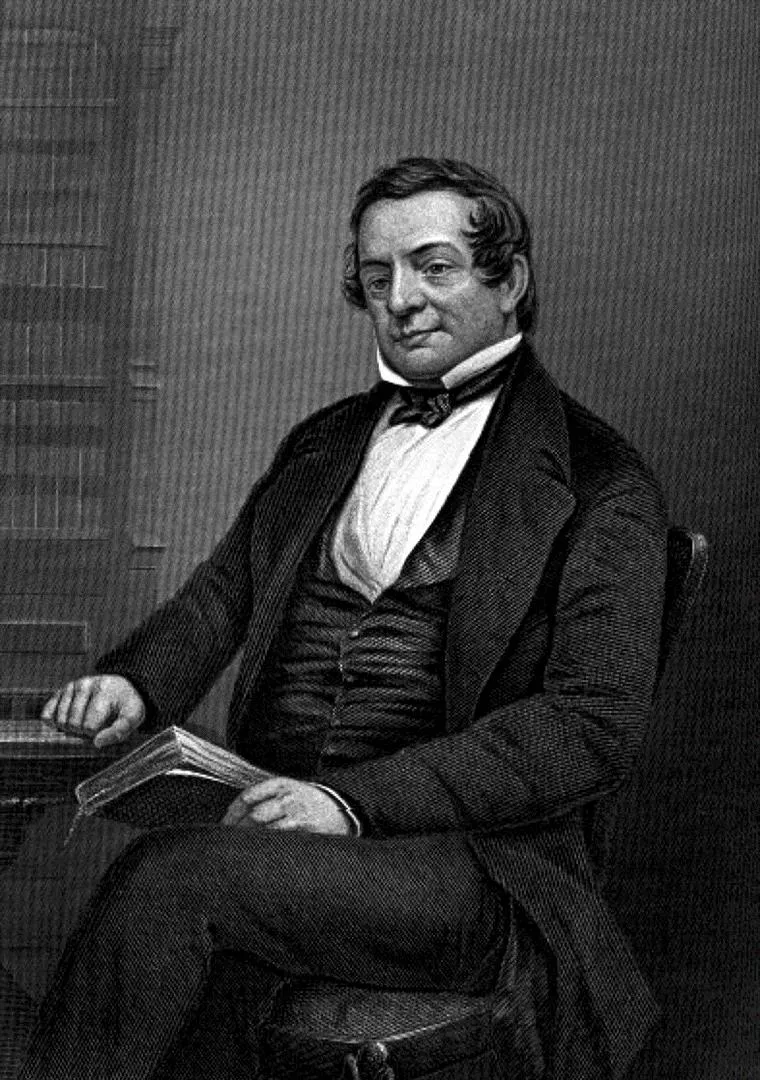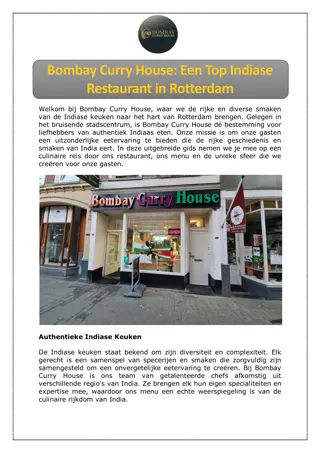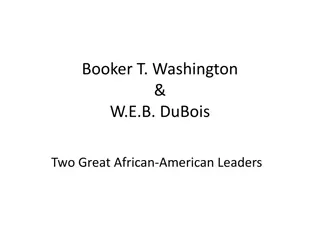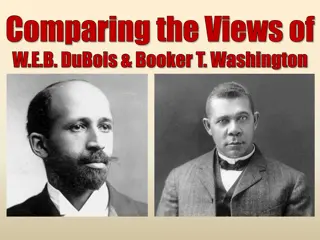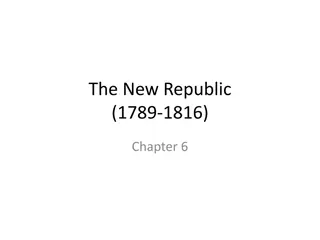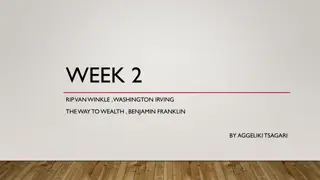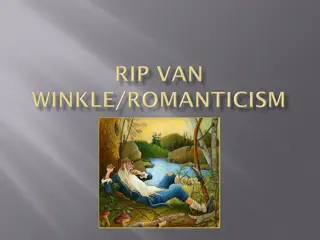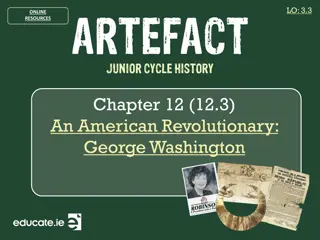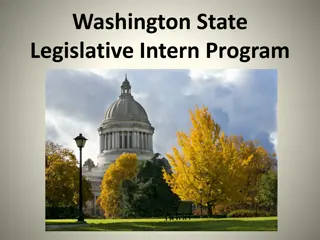Rip Van Winkle - A Classic American Tale by Washington Irving
Rip Van Winkle, written by Washington Irving, is a timeless American story of a man who escapes his mundane life by venturing into a world of fantasy and vision. The narrative seamlessly weaves between reality and imagination as Rip's adventures unfold in the Catskill Mountains, capturing the essence of cultural folklore and societal dynamics of the era.
Download Presentation

Please find below an Image/Link to download the presentation.
The content on the website is provided AS IS for your information and personal use only. It may not be sold, licensed, or shared on other websites without obtaining consent from the author. Download presentation by click this link. If you encounter any issues during the download, it is possible that the publisher has removed the file from their server.
E N D
Presentation Transcript
RIP VAN WINKLE (1819) Washington Irving S. Nasreen Banu Assistant Professor of English
WASHINGTON IRVING (1783-1859) last of 11 children lived from end of Revolutionary War to just before the Civil War 1809: published parody History of New York, under the pseudonym Dietrich Knickerbocker; became celebrity ( New York Knicks NBA team) 1815: departed for Europe; away for 17 yrs. 1819: The Sketch Book, including Rip Van Winkle and The Legend of Sleepy Hollow, both based on German folktales
WASHINGTON IRVING (1783-1859) first American writer to be a big success in England 1828: The Life and Voyages of Christopher Columbus, research in Spain 1829-32: diplomat in London 1832-42: returns to U.S., builds home Sunnyside on Hudson River, New York 1842-46: minister to Spain 1851-59: 5 vol. life of George Washington
FINAL YEARS Irving returned to Europe for three years and then spent the final thirteen years of his life in New York. He continued writing, even as his authorial powers declined, until his death.
PLOT SUMMARY Rip Van Winkle is the classic American story of a man who finds his home life intolerable, and so escapes into a world of fantasy and vision Even before Rip goes into the mountains and apparently falls asleep for 20 yrs., the story is divided between reality and fantasy/vision
VISION VS. REALITY (1) In a village near the Catskill Mountains in New York lives a man named Rip Van Winkle a kind neighbour and henpecked husband. He is dutiful and quick to help his friends and neighbours, and is well liked. In addition to his termagant or fierce wife, he has children, including a son, also named Rip, who bears a strong resemblance to his father.
VISION VS. REALITY (2) Vision: Community anywhere outside the house Rip Van Winkle also has a dog, Wolf, who is also put upon by Dame Van Winkle , Rip s wife. Rip s farm is a constant source of trouble for him, and the only pleasure he derives is from his regular meetings with other men of the village, who meet outside the local pub, named after King George the Third of Great Britain, to discuss village gossip and other topics.
VISION VS. REALITY: RIPS JOURNEY One day, Rip Van Winkle goes for a walk up the Catskill Mountains, with his dog Wolf for company. As he is about to descend, he hears someone shouting his name. A strange, short man with a grey beard appears, wearing antique Dutch clothes. He beckons Rip to follow him, and they arrive at a woodland amphitheatre where strange people are playing ninepins. They are also dressed in old clothes. The man who has led Rip here has a keg of alcoholic drink, which he shares with these figures.
Rip tries the drink, and takes such a shining to it that he ends up drinking too much of it, and he sinks into a deep sleep. When he wakes up, all of the strange figures have gone, including the man with the keg of liquor. Rip s dog has also gone. The gun he d taken with him up the mountain has gone, and a rusted gun is there next to him instead.
POLITICAL ALLEGORY Upon waking, Rip finds himself in a different political system As he walks home, Rip realises his beard has grown a foot long. When he arrives back in his village, he meets people he doesn t know, and who don t know him. All of the shops and houses look different. When he goes into his home it s to find that it s rundown and deserted. Going out into the street, he finds that the pub he used to meet with friends outside has changed from the King George the Third to the General Washington.
Rip speaks with the villagers and asks if any of them know two of his oldest friends, whom he names. They tell him that those two friends have died. Rip asks them if anyone knows a man named Rip Van Winkle. They point to a man who looks just like Rip: his son, now grown up and resembling his father.
Rips daughter, also grown up, appears with a baby. Rip asks her who her father was. She replies that his name was Rip Van Winkle, but that he disappeared twenty years ago after he went for a walk in the mountains. They feared he d been captured by Native Americans, or had shot himself. It turns out that Rip Van Winkle thought he d slept for one night, but he had in fact been asleep for twenty years.
When Rip sees his son, a precise counterpart of himself as he went up the mountain: apparently as lazy, and certainly as ragged. The poor fellow was now completely confounded. He doubted his own identity ( 45)
Rip stands for Americas identity crisis as a new democracy: God knows. . . . I m not myself I m somebody else that s me yonder no that s somebody else, got into my shoes I was myself last night, but I fell asleep on the mountain, and they ve changed my gun, and ever thing s changed, and I m changed, and I can t tell what s my name, or who I am! ( 46)
POLITICAL ALLEGORY According to this allegorical reading, his wife stands for England: there was one species of despotism under which he had long groaned, and that was petticoat government the tyranny of Dame Van Winkle ( 60)
POLITICAL ALLEGORY Rip asks his daughter what happened to her mother (Rip s wife). Upon learning that she has died, Rip is relieved, so henpecked was he! At this point, Old Peter Vanderdonk, a descendant of a great historian, appears and corroborates Rip s story: he says that his ancestor told of Hendrick Hudson, the great explorer who helped to found North America and after whom the Hudson River was named, keeping a vigil in the Catskill Mountains every twenty years with his crew. Rip s visit to the mountains just happened to coincide with one of these vigils.
Rip settles down to watch his grandchild grow, and his son tends to the farm while Rip Senior enjoys his retirement. He eventually reacquaints himself with his remaining friends in the village, who take up their regular meets outside the pub, and Rip Van Winkle becomes revered as a village elder and patriarch who remembers what the village was like before the American Revolutionary War.
POLITICAL ALLEGORY Rip, in fact, was no politician; the changes of states and empires made but little impression on him ( 60) Thus, Rip is an anti-hero of the revolution, an anti-patriot, for whom politics makes little difference in daily life Rip becomes a patriarch and a chronicle of old times suggesting a society s need for memory as well as revolution
CONCLUSION: WHAT IS RIP VAN WINKLE ABOUT? Tradition and change American identity (German narrative transplanted to America) The power of myth The power of nature Gendered dimension of American imagination Domestic life vs. public life
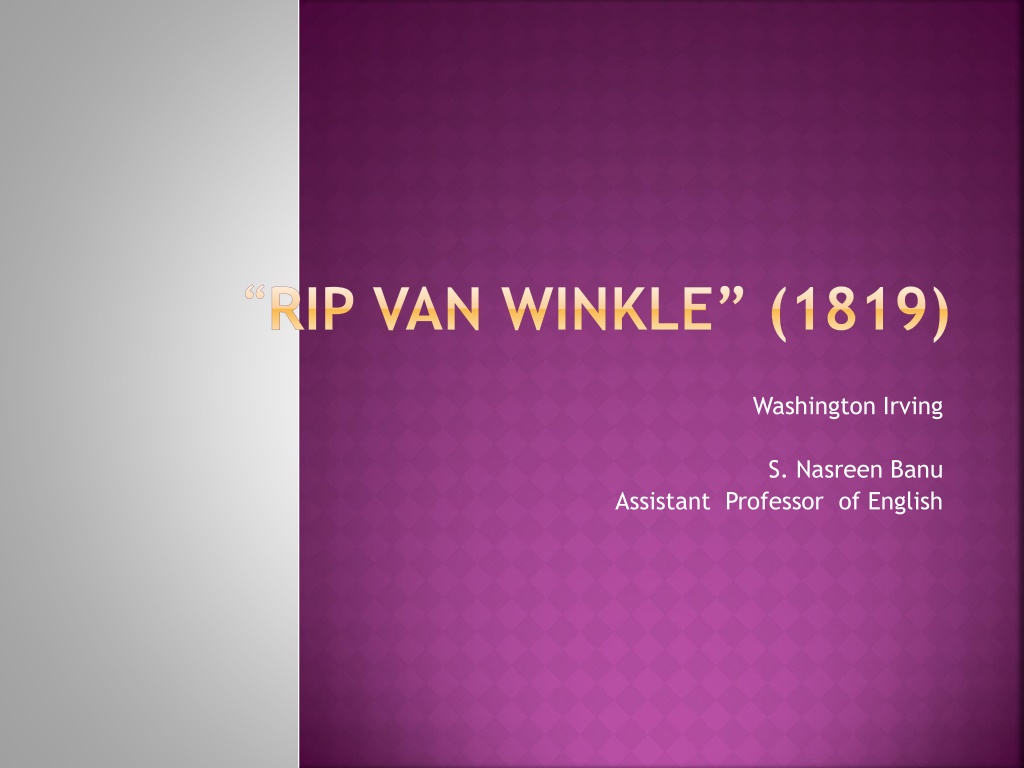
 undefined
undefined




